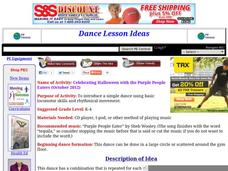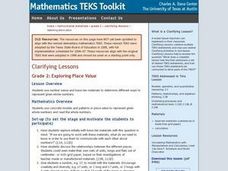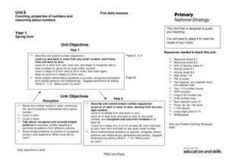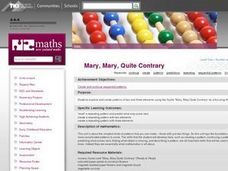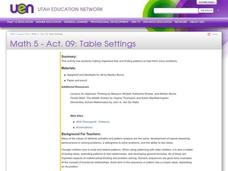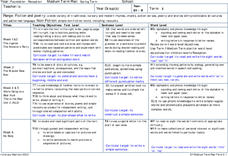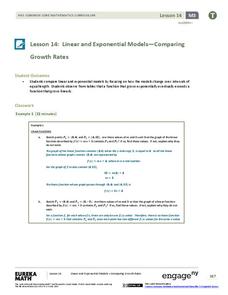Curated OER
Celebrating Halloween With the Purple People Eaters
Get youngsters moving by teaching them some basic dance moves. This dance can be done in a circle, a line, or scattered around the gym. There are four movement combinations that are taught to the song "Purple People Eater" by Sheb...
Curated OER
Grade 2: Exploring Place Value
Creative problem solving is fun and helps kids conceptualize content. They use grid paper, manilla paper, and markers to cut, draw, and show given double-digit numbers as many ways as they can.
Curated OER
Counting, Properties of Numbers, and Reasoning about Numbers
Five days of lessons develop number sense and counting patterns, including odd and even numbers, 5s and 10s, doubles, and ways to make 10. Each session opens with fun finger play to reinforce counting and reasoning about numbers. Various...
Illustrative Mathematics
Kitchen Floor Tiles
An interesting way to look at the kitchen floor is to count the number of tiles in the border. Fred starts with four white floor tiles and writes an expression for the number of tiles needed for the colored border. Algebra learners are...
EngageNY
Algebraic Expressions—The Distributive Property
Do your classes truly understand the distributive property? Use a demonstrative lesson to represent the distributive property in various ways. Learners solidify understanding by creating a geometric pattern for distributive...
EngageNY
Numbers in Exponential Form Raised to a Power
Develop an understanding of the properties of exponents through this series of activities. This third lesson of 15 explores the patterns associated with the power property. Scholars expand the powers before applying the property.
Curated OER
Weaving a Story
It's time to investigate patterns! First and second graders construct a paper weaving using a hundreds chart, then use the Ti-10 calculator to make patterns such as adding 3 each time. Learners remove multiples of three from the hundreds...
Curated OER
African Asimevo Cloth
Students research and observe the patterns and colors in Asimevo cloh of the Ewe people of Ghana in Africa. They compare the Asimevo cloth to other African textiles, such as Kete, Adinkra, and Kente cloth. They then create visual...
Curated OER
Mary, Mary, Quite Contrary
First graders use simple vegetable cut out and colored paper flower peddles to make simple patterns. They start out with a simple 2-element patterns around the theme of a daisy and increase in difficulty.
Curated OER
Small and Large Squares
Young mathematicians classify squares according to attributes. They sort squares according to specific attributes. Students explore squares in repeating patterns and order squares according to size. Engaging extension activities are...
Curated OER
Rhythm and Counting
Students repeat patterns while listening to music. In this patterning lesson, students listen to a pattern on a tape of music and reproduce it by clapping or stamping their feet. They listen to stories about famous composers.
Curated OER
The Alphabet of Coins
Students use letter/sound relationships of initial consonants to complete sentences that follow a given repeating pattern. These sentences be based on coin terms found on the U.S. Mint H.I.P. Pocket Change™ Web site.
Curated OER
Tessellations
Students create tessellations. In this math lesson, students explore symmetry and patterns through the creation of a tessellation. Students design and create their own tessellation.
Curated OER
Terrific Tessellations
Students create, transform, and critique their own piece of artwork. In doing this lesson, students get more experience working with angles, lines, and measurement. They gain experience seeing, and creating their own patterns and shapes.
Curated OER
Teddy Bear, Teddy Bear
Young scholars identify and use patterns in oral and written language, as well as in sounds, physical movements, and concrete objects.
Curated OER
Table Settings
Fifth graders explore and examine how to make organized lists and find patterns to help them solve problems. They identify, analyze and determine a rule for predicting and extending numerical patterns involving operations of whole...
Curated OER
Fiction and Poetry
Students explore fictional text and poetry. They explore the story structures used in the types of texts and examine the language patterns used. Students practice tracking text in the correct manner.
Curated OER
Whose History Is It Anyway? Patterns in History
Read and examine primary source material in order to analyze, synthesize, and debate information about the Great Depression. Critical analysts research various source materials related to the Great Depression. They work in teams to...
EngageNY
Linear and Exponential Models—Comparing Growth Rates
Does a linear or exponential model fit the data better? Guide your class through an exploration to answer this question. Pupils create an exponential and linear model for a data set and draw conclusions, based on predictions and the...
Curated OER
Patterns
Second graders create an ABAB pattern with their name. In this early elementary math lesson, 2nd graders first model their names in an ABAB pattern with unifix cubes. They then recreate the pattern using letter stamps on KidPix.
Curated OER
Squaring Off
Students define examples of patterns and explore the makeup and purpose of patterns found in nature. They create models illustrating the patterns researched in class and relaying the purpose of patterns in various natural objects.
Curated OER
Identifying Shapes and Matching
Students recognize shapes and repeating shapes can make a pattern. In this patterns lesson, students identify pictures of shapes as patterns or not patterns. Students describe how the pattern is made.
Curated OER
Line Dance is a Pattern!
Fifth graders apply the pattern of a line dance to different music tempos.
Other popular searches
- Repeating Patterns in Shapes
- Repeating Patterns Art
- Math Repeating Patterns
- Repeating Patterns Poetry
- Repeating Patterns Science
- Repeating Patterns in Math
- Repeating Patterns in Music
- Growing and Repeating Patterns
